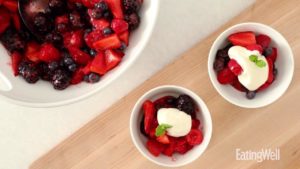What Is Chrononutrition
The definition of Chrononutrition is the interplay between nutrition and our circadian rhythm. Circadian rhythms are physical, mental and behavioral changes that follow a 24 our cycle, that includes eating, appetite, digestion and metabolism! We all have a master clock, which is located in the suprachiasmatic nucleus (SCN) in the brains hypothalamus. The master clock receives light signals from the eye’s retina and sends that information to various parts of the brain. Research has shown that eating at the wrong times could have a a major impact on our circadian rhythms. Our body responds better to consistency and timing of meals and consistency of when we have those meals is no different. It is not just what we eat, but when we eat. We should pay attention to meal timing and light exposure, meaning it is best to eat during daylight hours and on a regular schedule when possible.
What can affect circadian rhythm:
- Age
- Ethnicity
- Light/dark cycles
- Genetics
- Sleep
- Shift work
- Socializing
- Jett lag
Studies have shown that a disruption in circadian rhythm is associated with metabolic syndrome, obesity, cardiovascular disease and cancer. There are many areas of ongoing research regarding chrononutrition but I will focus on is studies related to obesity and diabetes. Glucose metabolism follows a circadian cycle through glucose tolerance that typically peak during daylight hours, when we usually eat and reduces when it is dark out and fasting usually happens. Insulin and cortisol fluctuate due to circadian cycles. It has been proven that insulin secretion and sensitivity are closely regulated by circadian control and have a strong affect on glucose metabolism. Choice of food alone seems to not dictate blood glucose control, meal timing plays a role as well. The same meal consumed at night versus the morning may affect blood glucose control. Consuming less carbohydrate and increasing protein and fat at night for a person with diabetes has shown to produce better glycemic control. Studies have shown that eating the bulk of our calories earlier in the day can regulate weight and reduce risk of obesity as well.
So what can you do to create a healthy circadian eating cycle:
- Eat at consistent times. If you are having difficulty because of work, stress or lack of structure, set an alarm in your phone to remind you when to eat and snack.
- Try not to skip meals as that can trigger the hunger hormones grhelin and neuropeptide Y as they will make you overs consume later.
- Try to eat at least 4 hours apart. this can prevent overeating and grazing.
- Try and eat the majority of your calories during daylight hours. This can be difficult, especially during daylight savings, but consider switching your biggest meal to mid day when possible. Eating the majority of your calories at night has been linked to obesity and metabolic disorders.
The benefits of chrononutrition are still being researched, but it is beneficial to create structure with meals and try to consume our meals during daylight hours. If you want more help creating a healthy timed meal plan, reach out to your RD!
Butternut Squash and Quinoa Pilaf
Quinoa, butternut squash, and almonds combine to make this hearty vegetarian side dish.
Recipe Summary
Ingredients
Directions
Nutrition Facts
How Diet Can Help Prevent UTI’s (Urinary Tract Infections)
UTI’s (urinary tract infections) are common and sometimes recurrent infections that cause infection and inflammation due to bacteria, most commonly e-coli, entering the urethra. UTI’s can affect the urethra, bladder and/or kidneys. Some of the most common risk factors for recurrent UTI’s include: frequent sexual intercourse, diabetes, menopause, gender (females are at greater risk), constipation and bladder catheterization. What can you do?
- Make sure you are well hydrated. Drink 64 ounces of water a day, to help dilute urine.
- Wipe correctly. After urinating, wipe from front to back to avoid bacteria going where it shouldn’t go.
- Urinate after sex and have a glass of water!
- Do not use douches or other irritating feminine products.
- Move your bowels on a regular basis and do not allow yourself to become constipated.
Studies have shown that nutrition can play a role in reducing recurrent UTI’s, but medication is the main line of treatment once a UTI is present. Things you can eat/take to reduce risk:
- Cranberries and blueberries have a flavinols, epicatechin in particular, which is an inhibitor of bacteria from sticking to the urinary tract lining. Other fruits such as apples, cherries and plums also have this flavinol, but berries have a much higher amount.
- Consume fermented foods that contain Lactobacilli and bifidobactria, as well as other strains. Greek yogurt and kefir are good examples. If you are not a fan of dairy or other fermented foods, I recommend a probiotic supplement. Jarrow femdophilus and Thorne Urisatin are two great targeted formulas.
- Consume foods that are high in Vitamin C. Broccoli, spinach, tomatoes, kiwi, oranges and lemons are all rich in Vitamin C.
- Reduce sugar consumption. Sugar creates a breeding ground for bacteria and feeds it. Avoid sugary juices, and other sweet treats. If you are going to drink cranberry juice, make sure it has no added sugar.
- Make sure you consume enough fiber. Constipation can make it difficult to empty your bladder completely, which allows bacteria to grow and cause infection. We should consume 25-36 grams of fiber a day. Some great sources of fiber include: apples, clementines, broccoli, cauliflower, berries, beans and whole grains.
If you suspect you have a UTI, always talk to your physician and get treatment if needed. Consuming these foods/supplements can prevent continuing infections, but cannot treat current infections. So stay hydrated, consume your fiber, Vitamin C rich foods, and take a probiotic or eat that yogurt!
This easy fruit salad recipe is a dazzler: a large bowl of colorful berries served with a cool lemon curd sauce. Use room-temperature fruit in this berry salad (or if you are taking the berries out of the refrigerator, set them in an oven that’s recently been on to gently warm them). The flavor of warm or room-temperature berries is so much better, as if they’re fresh-picked and still hold the warmth of the sun.
Ingredients
Directions
Tips
Make Ahead Tip: Make berry puree (Step 1) and lemon sauce (Step 2) and refrigerate for up to 3 days. Combine fresh berries with the puree about 1 hour before serving.
Tip: Look for prepared lemon curd–a custardy spread–near the jams in well-stocked supermarkets or specialty-foods stores. Try leftover curd on toasted baguette. Alternatively, omit Step 2 and use lemon-flavored Greek yogurt to top the berry salad.





